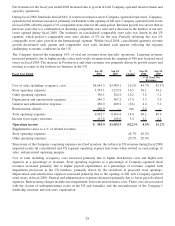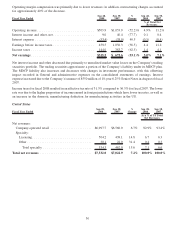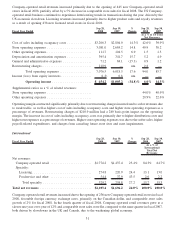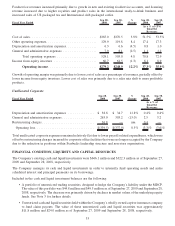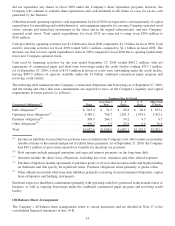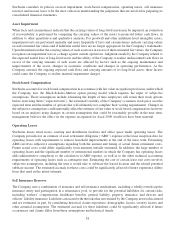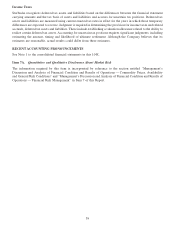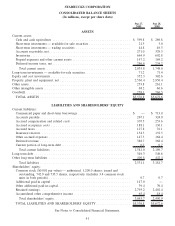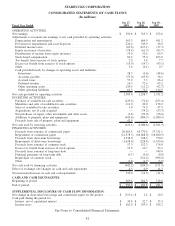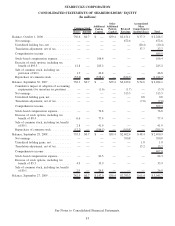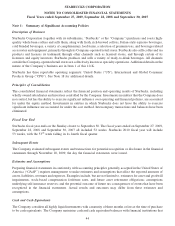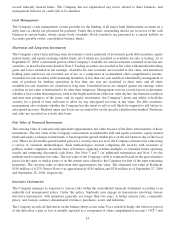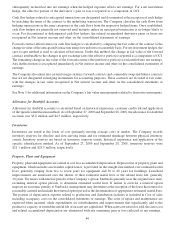Starbucks 2009 Annual Report Download - page 44
Download and view the complete annual report
Please find page 44 of the 2009 Starbucks annual report below. You can navigate through the pages in the report by either clicking on the pages listed below, or by using the keyword search tool below to find specific information within the annual report.COMMODITY PRICES, AVAILABILITY AND GENERAL RISK CONDITIONS
Commodity price risk represents the Company’s primary market risk, generated by its purchases of green coffee and
dairy products, among other things. The Company purchases, roasts and sells high-quality whole bean arabica
coffee and related products and risk arises from the price volatility of green coffee. In addition to coffee, the
Company also purchases significant amounts of dairy products to support the needs of its Company-operated retail
stores. The price and availability of these commodities directly impacts the Company’s results of operations and can
be expected to impact its future results of operations. For additional details see Product Supply in Item 1, as well as
Risk Factors in Item 1A of this 10-K.
FINANCIAL RISK MANAGEMENT
Market risk is defined as the risk of losses due to changes in commodity prices, foreign currency exchange rates,
equity security prices, and interest rates. The Company manages its exposure to various market-based risks
according to an umbrella risk management policy. Under this policy, market-based risks are quantified and
evaluated for potential mitigation strategies, such as entering into hedging transactions. The umbrella risk
management policy governs the hedging instruments the business may use and limits the risk to net earnings.
The Company also monitors and limits the amount of associated counterparty credit risk. Additionally, this policy
restricts, among other things, the amount of market-based risk the Company will tolerate before implementing
approved hedging strategies and prohibits speculative trading activity. In general, hedging instruments do not have
maturities in excess of five years.
The sensitivity analyses disclosed below provide only a limited, point-in-time view of the market risk of the
financial instruments discussed. The actual impact of the respective underlying rates and price changes on the
financial instruments may differ significantly from those shown in the sensitivity analyses.
Commodity Price Risk
The Company purchases commodity inputs, including coffee, dairy products and diesel that are used in its
operations and are subject to price fluctuations that impact its financial results. In addition to fixed-price contracts
and price-to-be-fixed contracts for coffee purchases, the Company has entered into commodity hedges to manage
commodity price risk using financial derivative instruments. The Company performed a sensitivity analysis based
on a 10% change in the underlying commodity prices of its commodity hedges, as of the end of fiscal 2009, and
determined that such a change would not have a significant effect on the fair value of these instruments.
Foreign Currency Exchange Risk
The majority of the Company’s revenue, expense and capital purchasing activities are transacted in US dollars.
However, because a portion of the Company’s operations consists of activities outside of the US, the Company has
transactions in other currencies, primarily the Canadian dollar, British pound, euro, and Japanese yen. As a result,
Starbucks may engage in transactions involving various derivative instruments to hedge revenues, inventory
purchases, assets, and liabilities denominated in foreign currencies.
As of September 27, 2009, the Company had forward foreign exchange contracts that hedge portions of anticipated
international revenue streams and inventory purchases. In addition, Starbucks had forward foreign exchange
contracts that qualify as accounting hedges of its net investment in Starbucks Japan, as well as the Company’s net
investments in its Canada subsidiary, to minimize foreign currency exposure.
The Company also had forward foreign exchange contracts that are not designated as hedging instruments for
accounting purposes (free standing derivatives), but which largely offset the financial impact of translating certain
foreign currency denominated payables and receivables. Increases or decreases in the fair value of these hedges are
generally offset by corresponding decreases or increases in the US dollar value of the Company’s foreign currency
denominated payables and receivables (i.e. “hedged items”) that would occur within the hedging period.
The following table summarizes the potential impact to the Company’s future net earnings and other comprehensive
income (“OCI”) from changes in the fair value of these derivative financial instruments due in turn to a change in the
36





